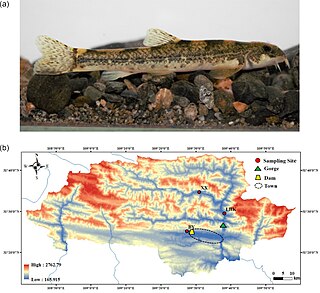
Triplophysa is a genus of fish in the family Nemacheilidae found mainly in and around the Qinghai-Tibet Plateau in China. Currently, the genus is a mixed assemblage of species. Some lineages have been identified and treated as subgenera, but as Wikipedia follows Fishbase for fish species all but Hedinichthys have been treated as subgenera in Wikipedia, although Kottelat in his revision of the loaches did recognise them as valid. FishBase, however, includes these in Triplophysa without specifying subgenera and treats the names given by Kottelat as synonyms.
Triplophysa alexandrae is a species of stone loach in the genus Triplophysa endemic to Sichuan, China.
Triplophysa arnoldii is a species of stone loach in the genus Triplophysa. It is endemic to Mongolia. It grows to 7 cm (2.8 in) SL.

Triplophysa bleekeri is a species of stone loach in the genus Triplophysa. It is endemic to China. It grows to 8.2 cm (3.2 in) TL. Having a wide distribution across the Qinghai-Tibet Plateau, it lives in fast-flowing rivers from 200 to 3,000m in altitude. Being an unusual species inhabiting high-altitude regions, it is an excellent model to investigate the genetic mechanisms of adaptation to the local environment. With this in mind a chromosomal-scale genome assembly was sequenced and assembled with a genome size of ∼628 Mb. This data finding that the Triplophysa genus likely diverged when the Qinghai-Tibet Plateau elevated by >4,000 m roughly 40 million years ago.
Triplophysa brahui is a species of stone loach in the genus Triplophysa. It is found in Baluchistan, Pakistan and in the Helmand River watershed in Afghanistan.
Triplophysa farwelli is a species of stone loach in the genus Triplophysa. It is found in Iran and the Helmand River drainage in Afghanistan.
Triplophysa gracilis is a species of stone loach in the genus Triplophysa. It is found in Pakistan, India, and China. It grows to 11 cm (4.3 in) SL and lives in standing waters and deeper parts of rivers.
Triplophysa gundriseri is a species of stone loach from Mongolia and Tuva (Russia).

Triplophysa intermedia is a species of stone loach in the genus Triplophysa. The species has only been found in Hulun Lake in Inner Mongolia, China; but is believed to appear in other locations as well since fish in this genus are typically found in running water.
Triplophysa longibarbata is a species of ray-finned fish in the genus Triplophysa. This cavefish is only known from Guizhou in China.
Triplophysa minuta is a species of ray-finned fish in the genus Triplophysa.
Triplophysa nasobarbatula is a species of ray-finned fish in the genus Triplophysa.
Triplophysa nujiangensa is a species of ray-finned fish in the genus Triplophysa.

The Tibetan stone loach is a species of ray-finned fish in the family Nemacheilidae. The specific name is sometimes spelled stoliczkae but the original spelling used by Steindachner is stoličkai. It is found in southern and central Asia.
Triplophysa tenuicauda is a species of stone loach in the genus Triplophysa, found in China, India and Pakistan.
Triplophysa waisihani is a species of ray-finned fish in the genus Triplophysa.
Triplophysa zhaoi is a species of ray-finned fish in the genus Triplophysa. It grows to 8 cm (3.1 in) SL. It is endemic to China and inhabits swampy creeks.
Qinghaichthys is a subgenus the genus Triplophysa, stone loaches native to China. Some authorities recognise this as a valid genus but this is not recognised by Fishbase.
Tarimichthys is a subgenus of stone loach genus Triplophysa native to China which contains two species. Some authorities recognise Tarimichthys as a valid taxon.

Solomon Markovich Herzenstein was a Russian zoologist.




